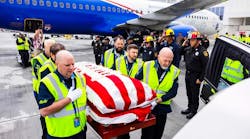On Wednesday, July 4th, 2012, Transport Canada issued the long expected and final amendments to the CARs affecting what aircraft do and do not require TAWS (Terrain Awareness Warning Systems).
The new TAWS regulations apply to virtually all commercial air taxi, commuter and/or airline operations. These fall into the CARs Subparts 703, 704 and 705. The new regulations will also apply to private operators of turbine-powered aircraft with 6 or more pax seats.
The new regulations are effective immediately for airplanes manufactured on or after July 4, 2012. They also apply to newly manufactured aircraft that enter Canada on a leaseback arrangement.
Aircraft manufactured before July 4, 2012 have two (2) years after the date of Final Rule to have a TSO C151b compliant TAWS Systems installed and Transport Canada certified. All TAWS Systems must be compliant with the EAA requirement within 5 years of the date of Final Rule.
Under the new regulations TAWS is required for airplanes involved in the following CARs categories of operation:
CAR Subparts Regulatory Requirements
Subpart 605 Private turbine-powered aeroplanes and commercial aircraft configured with six or more seats, excluding pilot seats, except when operated DAY Visual Flight Rules, will be required to be equipped with Class A or B TAWS with EAA functionality.
Subpart 703 Aeroplanes configured with six or more seats, excluding pilot seats, except when operated DAY Visual Flight Rules, will be required to be equipped with Class A or B TAWS with EAA functionality.
Subpart 704 Aeroplanes configured with six to nine passenger seats, except when operated DAY
Visual Flight Rules, will be required to be equipped with Class A or B TAWS with EAA functionality.
Aeroplanes configured with 10 or more passenger seats, exclusive of pilot seats, except when operated DAY Visual Flight Rules, would be required to be equipped with Class A TAWS with EAA functionality, a terrain awareness and situational display.
Subpart 705 Aeroplanes will be required to be equipped with Class A TAWS with EAA functionality, a terrain awareness and situational display. The full and complete published amended regulation is online at http://www.gazette.gc.ca/rppr/p2/2012/2012-07-04/html/sor-dors136-eng.html.
Background:
According to information from Transport Canada contained in the regulatory change documents for TAWS, the number of CFIT incidents tracked from 1977 to 2009 has driven this new regulation. During that period 35 airworthy aeroplanes were flown into the ground while under pilot control. More properly termed controlled flight into terrain (CFIT) accidents, there were 100 fatalities and 46 serious injuries during that reporting period. Unfortunately there have been a rash of incidents since then that have driven those numbers significantly higher.
Transport Canada did start to look at this issue back in the mid 1990s – following FAA’s TAWS
rulemaking activity. Canadian TAWS rules have been bogged down since that time in a series of delays involving studies on everything from costs efficiencies through to aircraft applicability and implementation.
The CARs have required that aircraft operated under Subpart 705 - Airline Operations - be equipped with a Ground Proximity Warning System (GPWS) since the mid-1980s. The technology at the core of GPWS has evolved and today virtually eliminates the CFIT risk.
GPWS out - TAWS in:
The new generation of GPWS, better known as TAWS, provides:
• Predictive rather than Reactive aural and visual warnings of an impending collision with terrain or obstacles under conditions GPWS cannot;
• A “forward-looking” terrain display, based on real-time comparison of an aircraft’s location,
bearing, and speed with stored terrain data; and
• Calculation of a terrain clearance “floor,” based on calculated distance to a specified runway
threshold location, which provides alerts and warnings independent of landing gear or flap
settings.
There are two classes of TAWS equipment available, TSO C151b Class A and Class B.
• Class A TAWS is intended for larger aeroplanes.
• Class B is intended for smaller aeroplanes.
• Both classes have the terrain look-ahead functions, called Forward Looking Terrain Avoidance
(FLTA), and the unsafe terrain clearance function, called Premature Descent Algorithm (PDA),
in addition to the basic GPWS function.
• Because Class B TAWS is intended for smaller aeroplanes, it has reduced GPWS modes
compared to Class A TAWS and is simpler and less expensive to install.
• Class A TAWS requires a Terrain Display, while Class B TAWS does not, however we strongly
recommend a Terrain Display for all TAWS installations.
• Non-TSO’d Advisory Terrain Systems and Synthetic Vision Systems do not meet the
requirements of TSO’d TAWS Systems
About Enhanced Altitude Accuracy Requirement . . . or EAA
The Transport Canada TAWS regulations also require that TAWS equipment incorporate Enhanced Altitude Accuracy functionality. Most, but not all current TAWS Systems do meet this requirement. This EAA function uses GPS Altitude or algorithms including GPS Altitude to derive an accurate altitude calculation for the aircraft at all times irrespective of the Baro-Setting of the Pilot’s Altimeter. Accordingly the TAWS protection envelope is always accurate. Baro-Corrected Altitude from an AirData Computer does not meet the EAA requirement, as the possibility exists for the crew to input an incorrect Altimeter Baro-Setting, which would thereby inhibit the TAWS from fully protecting the aircraft from CFIT. The Transport Canada EAA requirement makes good sense in our opinion!
Note - Aircraft that are already equipped with TAWS Systems utilizing a Baro-Corrected ADC Altitude Source will have to be upgraded to meet the EAA requirement. Please feel welcome to call either Barry Aylward or Bill Arsenault if you have questions!
International TAWS Regulations in comparison.
In their final publication of the new TAWS regulations, Transport Canada TAWS rules have two important differences from the rest of the world. First is the Enhanced Altitude Accuracy requirement, and second is that the FAA and ICAO requirements apply only to turbine-powered airplanes. Transport Canada TAWS rulemaking encompasses all passenger-carrying aeroplanes in commercial operations.
KAAV, MC2 and TAWS Providers
Kitchener Aero and Mid-Canada Mod Center have a respected and acknowledged industry leadership in Canada for the design, installation and certification of complex avionics upgrades and mods that include TAWS. This covers all the aircraft operational categories affected by the new TAWS regulations.
As is the case with any mod or update, cost can vary widely based on the type of aircraft, the existing avionics configuration, the type of TAWS required, and of course the amount of work involved. While there can be similarities, no two airframes are ever exactly the same. Therefore every quotation for TAWS upgrades will be unique.
While a Terrain Display is required on Class A TAWS installations, it is technically optional on Class B TAWS installations. However based on working feedback from current TAWS clients and an complete understanding of the system usage and operations under real situations, a display really should be part of all TAWS installations. Any added cost will be offset by greatly enhanced situational awareness at all times.
KAAV and MC2 are authorized dealers for Garmin, Honeywell, Sandel and Universal – key OEM providers of TAWS systems.


